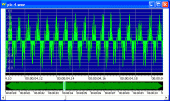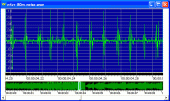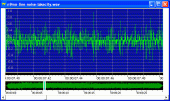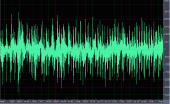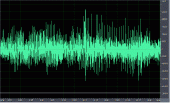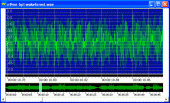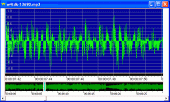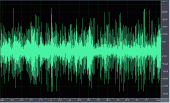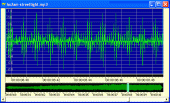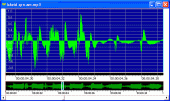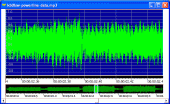The files in this section are recordings of RF noise from electric utilities, BPL and industrial equipment. If you can match noise at your location to one of these files then you can be confident that you know where your noise is coming from. Now all you have to do is find it and fix it!
RFI Noise
-
Contributor: Jacques, VE3VIA
Noise Source: Power Line Controls (PLC)
Where Found: Longwave band, various locations depending on the system in use.
Notes: PLCs are used for industrial control, and in commercial applications for applications like control of HVAC systems. They're finding increased use in homes and apartment buildings and condos as well. The X-10 control system is a basic PLC system that has been around for many years. PLCs use existing powerlines to send control signals, sort of a precursor to Broadband Over Powerline (BPL) that threatens reception on the HF bands. -
Contributor: Pete, N4ZR
Noise Source: Sounds like powerline noise.
Where Found: 80 metre band.
Notes: Recorded in the morning, so no skywave reception. Background noise is approx S5 and bursts are S9+20. Sometimes nearly continuous. -
Contributor: Don, N9MN
Noise Source: Powerline noise.
Where Found: 2 metre band, AM.
Notes: Powerline noise recorded on the 2 metre band in AM mode while mobile. -
Contributor: Don, N9MN
Noise Source: Powerline noise.
Where Found: 2 metre band, AM.
Notes: Powerline noise recorded on the 2 metre band in AM mode while mobile.
-
Contributor: Don, N9MN
Noise Source: Broadband Power Line (BPL)
Where Found: Recordings were made in the 10 metre band. However, BPL generally covers much of the HF spectrum
Notes: BPL is probably the biggest threat to amateur radio ever to come along. It threatens every form of HF communication. Support your local ham club and your national amateur radio organization in the fight against BPL!
-
Contributor: Don, N9MN
Noise Source: Broadband Power Line (BPL)
Where Found: Recordings were made in the 10 metre band. However, BPL generally covers much of the HF spectrum
Notes: BPL is probably the biggest threat to amateur radio ever to come along. It threatens every form of HF communication. Support your local ham club and your national amateur radio organization in the fight against BPL!
-
Contributor: Torbjorn, W4TDK/SM6YXK
Noise Source: Powerline Noise
Where Found: Recordings were made on 13,690 and 14,319 kHz. However, this kind of noise can occur in many places in the HF spectrum
Notes: Torbjorn received excellent service from his local power utility. Power was turned off for several blocks around his QTH, and the noise was eventually isolated to a ground wire on pole-mounted lightning arrestors that had burned through in two places and were just barely making contact. The wire was repaired and the noise disappeared. The customer (W4TDK) is happy, and the power company fixes a potentially dangerous situation. Everyone wins!
-
w4tdk-14319-usb Powerline Noise
Contributor: Torbjorn, W4TDK/SM6YXK
Noise Source: Powerline Noise
Where Found: Recordings were made on 13,690 and 14,319 kHz. However, this kind of noise can occur in many places in the HF spectrum
Notes: Torbjorn received excellent service from his local power utility. Power was turned off for several blocks around his QTH, and the noise was eventually isolated to a ground wire on pole-mounted lightning arrestors that had burned through in two places and were just barely making contact. The wire was repaired and the noise disappeared. The customer (W4TDK) is happy, and the power company fixes a potentially dangerous situation. Everyone wins!
-
High Pressure Sodium Streetlight
Contributor: Sam, KS2AM
Noise Source: High Pressure Sodium Streetlight
Where Found: 160m Band
Notes: "The noise is from High Pressure Sodium streetlights and area lights in my neighbourhood. The problem with these lights is that when they begin to fail they will generate a terrific amount of noise as they are trying to restart themselves or while they are shutting off. Typically this cycle will repeat every minute or so.The frequency is 1885 Kc and the mode is AM. On the recording you will hear an AM station in QSO and the noise will build, making the station unreadable. The station was peaking at about S9 and the streetlight reached S9+20 on peaks. This recording was probably a combination of more than one streelight but it's difficult to be sure."
-
k6eid-qrn-am 250kV Powerline Noise
Contributor: Phil, K6EID
Noise Source: 250 kV powerlines
Where Found: 160m Band
Notes: "This noise has been on for the last week or two for 24 hours a day. The recording was made at 1500 EDT today 1 April on 160 meter using AM. The peaks were S9 on 160, S7 on 80, S5 on 40. I tracked it using a clear AM channel on the car radio and found that it is being radiated by 250 kVA power lines along SR120 (it is so strong that it blocks local AM stations!). The lines run about 4 miles and the signal is constant level from one end to the other. When you move a block or so from the end of the lines, the signal disappears. I reported it on Monday to the utility Cobb EMC. They promised to look at it in a day or so but still going strong."
-
Contributor: Shawn, KB0LSW
Noise Source: Data Transmitted Via Powerlines
Where Found: 12.5 kHz, VLF
Notes: "Here is a data signal I received March 3rd using a VLF receiver. The signal is centered at about 12.5 kHz. This appears to be some sort of data being sent over the power lines. The signal was heard with the greatest amplitude at a major electric sub-station where several high voltage lines converge. I'm unsure if the transmission freq was 13 kHz or if 13 kHz is a carrier on a higher frequency (such as in the HF band). Several data bursts could be heard of varying strength communicating with each other and possibly acting as relays down the power grid."
Technology >> Radio Frequency Interference (RFI) >> Sounds of RFI >> Utilities
